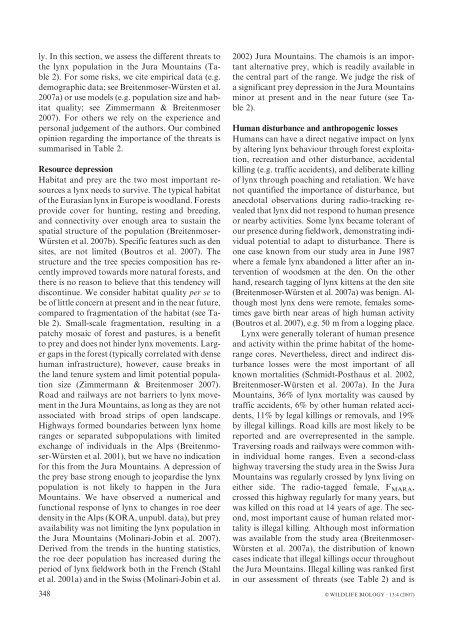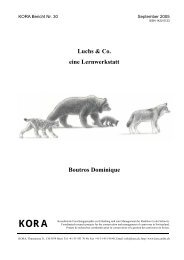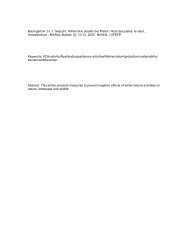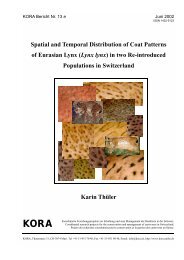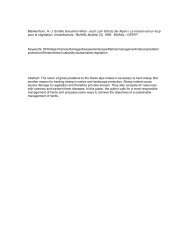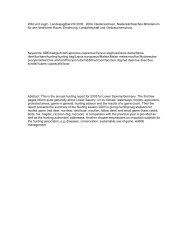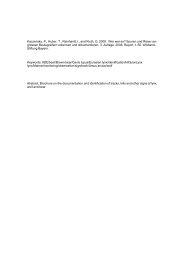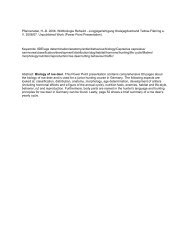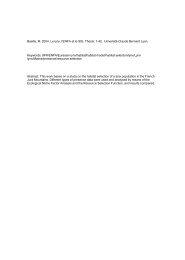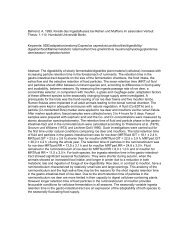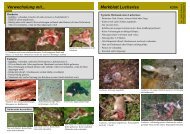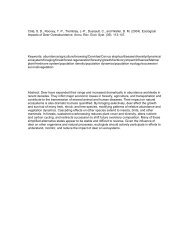Breitenmoser, U., Breitenmoser-Würsten, Ch., Capt, S ... - Kora
Breitenmoser, U., Breitenmoser-Würsten, Ch., Capt, S ... - Kora
Breitenmoser, U., Breitenmoser-Würsten, Ch., Capt, S ... - Kora
You also want an ePaper? Increase the reach of your titles
YUMPU automatically turns print PDFs into web optimized ePapers that Google loves.
ly. In this section, we assess the different threats to<br />
the lynx population in the Jura Mountains (Table<br />
2). For some risks, we cite empirical data (e.g.<br />
demographic data; see <strong>Breitenmoser</strong>-Würsten et al.<br />
2007a) or use models (e.g. population size and habitat<br />
quality; see Zimmermann & <strong>Breitenmoser</strong><br />
2007). For others we rely on the experience and<br />
personal judgement of the authors. Our combined<br />
opinion regarding the importance of the threats is<br />
summarised in Table 2.<br />
Resource depression<br />
Habitat and prey are the two most important resources<br />
a lynx needs to survive. The typical habitat<br />
of the Eurasian lynx in Europe is woodland. Forests<br />
provide cover for hunting, resting and breeding,<br />
and connectivity over enough area to sustain the<br />
spatial structure of the population (<strong>Breitenmoser</strong>-<br />
Würsten et al. 2007b). Specific features such as den<br />
sites, are not limited (Boutros et al. 2007). The<br />
structure and the tree species composition has recently<br />
improved towards more natural forests, and<br />
there is no reason to believe that this tendency will<br />
discontinue. We consider habitat quality per se to<br />
be of little concern at present and in the near future,<br />
compared to fragmentation of the habitat (see Table<br />
2). Small-scale fragmentation, resulting in a<br />
patchy mosaic of forest and pastures, is a benefit<br />
to prey and does not hinder lynx movements. Larger<br />
gaps in the forest (typically correlated with dense<br />
human infrastructure), however, cause breaks in<br />
the land tenure system and limit potential population<br />
size (Zimmermann & <strong>Breitenmoser</strong> 2007).<br />
Road and railways are not barriers to lynx movement<br />
in the Jura Mountains, as long as they are not<br />
associated with broad strips of open landscape.<br />
Highways formed boundaries between lynx home<br />
ranges or separated subpopulations with limited<br />
exchange of individuals in the Alps (<strong>Breitenmoser</strong>-Würsten<br />
et al. 2001), but we have no indication<br />
for this from the Jura Mountains. A depression of<br />
the prey base strong enough to jeopardise the lynx<br />
population is not likely to happen in the Jura<br />
Mountains. We have observed a numerical and<br />
functional response of lynx to changes in roe deer<br />
density in the Alps (KORA, unpubl. data), but prey<br />
availability was not limiting the lynx population in<br />
the Jura Mountains (Molinari-Jobin et al. 2007).<br />
Derived from the trends in the hunting statistics,<br />
the roe deer population has increased during the<br />
period of lynx fieldwork both in the French (Stahl<br />
et al. 2001a) and in the Swiss (Molinari-Jobin et al.<br />
2002) Jura Mountains. The chamois is an important<br />
alternative prey, which is readily available in<br />
the central part of the range. We judge the risk of<br />
a significant prey depression in the Jura Mountains<br />
minor at present and in the near future (see Table<br />
2).<br />
Human disturbance and anthropogenic losses<br />
Humans can have a direct negative impact on lynx<br />
by altering lynx behaviour through forest exploitation,<br />
recreation and other disturbance, accidental<br />
killing (e.g. traffic accidents), and deliberate killing<br />
of lynx through poaching and retaliation. We have<br />
not quantified the importance of disturbance, but<br />
anecdotal observations during radio-tracking revealed<br />
that lynx did not respond to human presence<br />
or nearby activities. Some lynx became tolerant of<br />
our presence during fieldwork, demonstrating individual<br />
potential to adapt to disturbance. There is<br />
one case known from our study area in June 1987<br />
where a female lynx abandoned a litter after an intervention<br />
of woodsmen at the den. On the other<br />
hand, research tagging of lynx kittens at the den site<br />
(<strong>Breitenmoser</strong>-Würsten et al. 2007a) was benign. Although<br />
most lynx dens were remote, females sometimes<br />
gave birth near areas of high human activity<br />
(Boutros et al. 2007), e.g. 50 m from a logging place.<br />
Lynx were generally tolerant of human presence<br />
and activity within the prime habitat of the homerange<br />
cores. Nevertheless, direct and indirect disturbance<br />
losses were the most important of all<br />
known mortalities (Schmidt-Posthaus et al. 2002,<br />
<strong>Breitenmoser</strong>-Würsten et al. 2007a). In the Jura<br />
Mountains, 36% of lynx mortality was caused by<br />
traffic accidents, 6% by other human related accidents,<br />
11% by legal killings or removals, and 19%<br />
by illegal killings. Road kills are most likely to be<br />
reported and are overrepresented in the sample.<br />
Traversing roads and railways were common within<br />
individual home ranges. Even a second-class<br />
highway traversing the study area in the Swiss Jura<br />
Mountains was regularly crossed by lynx living on<br />
either side. The radio-tagged female, F MARA ,<br />
crossed this highway regularly for many years, but<br />
was killed on this road at 14 years of age. The second,<br />
most important cause of human related mortality<br />
is illegal killing. Although most information<br />
was available from the study area (<strong>Breitenmoser</strong>-<br />
Würsten et al. 2007a), the distribution of known<br />
cases indicate that illegal killings occur throughout<br />
the Jura Mountains. Illegal killing was ranked first<br />
in our assessment of threats (see Table 2) and is<br />
348 E WILDLIFE BIOLOGY ? 13:4 (2007)


